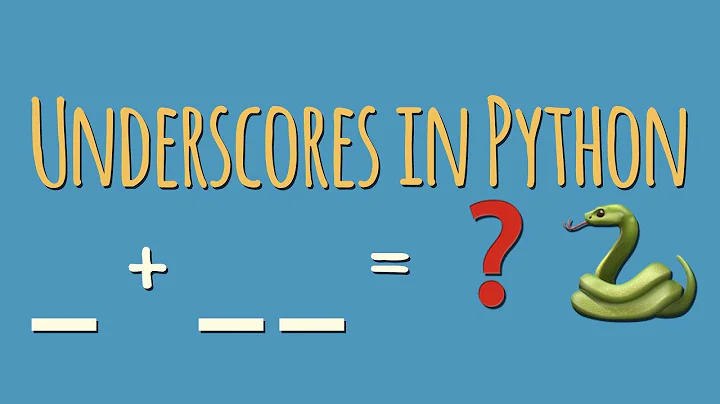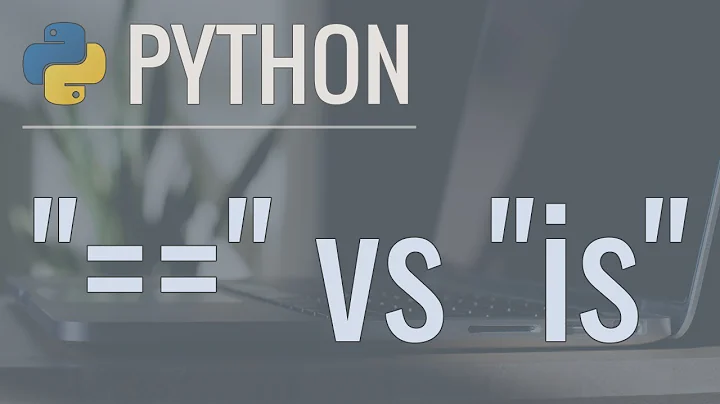What does "if var" mean in python?
Solution 1
in python, writing
if var:
has the same effect as writing
if bool(var):
(where bool is the built-in bool type which also acts as a constructor function for bool objects).
If the value is already a bool (valued True or False) the meaning is clear -- bool(var) returns the same value. For other types, there's almost always a conversion to bool avaliable which depends on the type. For integers (as in C) it's the same as var!=0; for lists or dicts or strings, it's the same as len(var)!=0, and so forth. You can find this in the python docs.
When you define your own class you can define a method via def __nonzero__(self): , which will be called in this context (when your object is passed to bool explicitly, or implicitly in an if -- or while for that matter).
A notable exception: numpy array objects do not convert to bool (they raise an exception). They need to be explicitly converted using constructs like (arr!=0).any() or (arr>0).all()
On similar lines: Don't get into the habit of writing any of
if x == True: # This only works as expected when x is a bool, or 0, or 1
if x is True: # Can be useful but you need to understand what it really means.
if x == None: # Often works as expected, except when it doesn't
Comparison to None should always be done with
if x is None:
(or)
if x is not None:
There is only one None object, and x is None will tell you if x refers to that object, and will always give you a bool (True if so, False for any other object). Comparing x==None (a mistake I frequently made when starting to use Python) will usually work, but it activates the generic comparison machinery of Python, which is not what you probably want; if x is an instance of a class, the comparison could raise an exception. is is simple and quick and just does that identity test - it can't be overloaded.
Likewise if x is True means "if x is the boolean object meaning true, and no other object at all" -- which can be useful, but is too narrow for the case when you are just testing truth value. Somebody might end up passing 1, which will fail an 'is True' test, but otherwise acts very much like True.
Solution 2
Behaviour differs a little bit from language to language.
Behaviour 1:
The variable is converted into a boolean. I.e. there are language specific conversions from different types into a boolean. For numeric values, 0 is usually converted into false while any other value is converted to true. As far as I know, this is the way Python does it.
Behaviour 2:
Booleans are numeric values. As above, 0 is usually the only value that evaluates to false
Behaviour 3:
Any non-null reference evaluates to true, null references evaluate to false.
This should more or less cover it, but there may be other variations or combinations as well, for instance using fallback to method 2 or 3 if 1 is not available. The point is that it's very much a language specific question.
Solution 3
There are lots of answers already that speak in the general term of "What if does in programming," so let me boil your code out for you.
def valid_day(day):
if day and day.isdigit():#if day
if signifies the beginning of the if block, and works as the other answers have pointed out. What follows is the boolean expression day and day.isdigit(). and is a Boolean operator that requires both operands (both sides of the equation, in layman's terms) to be True in order to evaluate as True. In this case, both day and day.isdigit() must evaluate to True for the if block to run.
In Python, we think of things as "Truthy" and "Falsey." It's easier to define "Truthy" in terms of "Falsey," because the latter is a much shorter list:
None- 0
- False
- [] "" {} () and the like
Everything else is "Truthy." If you type while -1: print("This loops forever") it will, in fact, loop forever. All non-zero numbers, all non-empty containers (strings, lists, dicts, sets, tuples, etc), anything not explicitly set to False or None will evaluate to True. In this case, the code is checking to make sure that day isn't None, because if it is then day.isdigit() will throw an AttributeError and break the code. You can try it yourself: type None.isdigit() in IDLE. Note that this is likely not the most foolproof implementation, since doing valid_day(31) will also throw AttributeError. valid_day requires a String, even though it's checking numbers.
day = int(day)
if day > 0 and day <= 31:
return day
This is actually repetitive code, since doing int(day) confirms day.isdigit(). If this is your code, perhaps consider a try: except block instead, such as:
def valid_day(day):
try: int(day)
except ValueError as e:
return False #this means whatever you passed to it can't be converted
#into an integer: maybe a floating point string?
if day in range(1,32): return True
else: return False
This will let you avoid the trap of checking for everything you know might fail. Instead, check to make sure your checks will be able to run, and let your program handle whatever you pass to it. This will also allow you to design a Day class that contains more information than an integer but will still return its calendar day using self.__int__(): return self.calendarday and valid_day(Day()) will return True. In addition, your current code returns None when you should be returning False -- as I mentioned above, None is Falsey, so in most cases this will work (e.g. if not valid_day: do_something_drastic()) but in some cases you may want to deal with a boolean directly.
Okay, there's a mouthful of words for you.
TL;DR: if starts the if block, day and day.isdigit() is true only when day is a non-empty string that contains an integer, and the rest does what it says it does.
Solution 4
The value of the variable is converted to a boolean, i.e. type coercion is performed. How this exactly happens depends on the language. In Python for example, an empty list evaluates to false. In most languages, 0 evaluates to false and any other number to true.
Then of course the variable might already contain a boolean value, e.g.
inBounds = day > 0 and day <= 31
if inBounds:
#...
Solution 5
if day: is a short way of writing if day == True:. When it evaluates the result of True == day, if day is a simple and basic object such as
integer, then the Python interpreter will try to call the built-in value comparison. If day is a class, the interpreter will call its __nonzero__ member function.
For example
class MyClass:
def __nonzero__(self):
return False
if __name__ == "__main__":
c = MyClass()
if c:
print "yes"
else:
print "No"
Related videos on Youtube
Comments
-
Alcides almost 2 years
This is a function in python to validate a day entry.
def valid_day(day): if day and day.isdigit():#if day day = int(day) if day > 0 and day <= 31: return dayI want to know what the expression
if daymeans (in terms of semantics).I only know the effect of
ifon boolean expressions not on variables like integers or arrays.-
greggo over 10 yearsFWIW, the function you give could be documented as: "'day' is expected to be None, or a possibly-empty string of digits; the result will be integer in range 1..31 (if conversion to such can be done) or None in other cases".
-
 Matthias over 10 yearsOne small addition. The last condition could be written as
Matthias over 10 yearsOne small addition. The last condition could be written asif 0 < day <= 31. -
greggo over 10 yearsWhile we are picking those nits - I'd write it as 1 <= day <= 31.
-
-
 Maxime Lorant over 10 yearsNope. 0 is evaluates to
Maxime Lorant over 10 yearsNope. 0 is evaluates tofalseand any other numbers totruein reality. -
 dstromberg over 10 yearsThis is an area where Python is somewhat different from other languages; in python, almost anything can be used in a boolean context like this. "if foo:" means "if foo is not empty".
dstromberg over 10 yearsThis is an area where Python is somewhat different from other languages; in python, almost anything can be used in a boolean context like this. "if foo:" means "if foo is not empty". -
 Felix Kling over 10 years@dstromberg: That's why I said "How this exactly happens depends on the language."
Felix Kling over 10 years@dstromberg: That's why I said "How this exactly happens depends on the language." -
 Steinar Lima over 10 yearsIt is a bit more complicated than that, e.g
Steinar Lima over 10 yearsIt is a bit more complicated than that, e.g'', empty lists andNone(among others) is evaluated to False. -
Ismail Badawi over 10 yearsThis is not true.
if dayevaluatesdayin a boolean context -- it has nothing to do withNone. Actually here it's checking for the empty string. -
 Siva Tumma over 10 yearsdo strings contain
Siva Tumma over 10 yearsdo strings containisdigit()method ? -
Ismail Badawi over 10 yearsYes. You can easily check this.
-
 Siva Tumma over 10 yearsAnd why are you expecting only strings will be passed as arguments to
Siva Tumma over 10 yearsAnd why are you expecting only strings will be passed as arguments tovalid_day? -
Ismail Badawi over 10 yearsI didn't write this code. If e.g. a nonzero int is passed, an
AttributeErrorwill be raised. But the function is obviously expecting strings, or it wouldn't be callingisdigit. -
 Siva Tumma over 10 yearsEmpty string is almost equivalent to
Siva Tumma over 10 yearsEmpty string is almost equivalent toNonethough not. We check likeif (param_value is None or param_value == ''):when we code for web server app that gets request parameters. But in general this style of coding means it is checking forNonebefore making calls of anobject's members (methods or member variables). -
Stuart over 10 years@dstromberg
if foo:in Python does not meanif foo is not empty. There are a number of ways that foo can be evaluated as False - see the other answers to this question. -
 Henrik over 10 years"I.e. there are language specific conversions from different types into a boolean." covers that, doesn't it?
Henrik over 10 years"I.e. there are language specific conversions from different types into a boolean." covers that, doesn't it? -
Adam Smith over 10 years@IsmailBadawi, we don't need to check for the empty string in this context, as
"".isdigit()will returnFalse. It is, in fact, checking forNonesinceNone.isdigit()will throw anAttributeErroras you correctly asserted. -
 Steinar Lima over 10 yearsSorry about that - i missed the
Steinar Lima over 10 yearsSorry about that - i missed thefor numeric valuespart of your answer :) -
greggo over 10 yearsIt's not the same. Suppose day='Friday'. then
if daywill test as true, andif day == Truewill test as False; a non-empty string has a 'true' truth value, but all comparisions using == between a string and a boolen value will yield False; no string is equal to a boolean value. -
greggo over 10 years
if day:is a short way of writingif bool(day):or, if you prefer (and I very much don't)if bool(day)==True: -
greggo over 10 yearsI've noticed that many programmers tend to have a style which is sort of 'in denial' of boolean expressions; they write
if(boolvar==true)(I'm in C++ now) and, worse,if(x<0)is_neg = true; else isneg=false;I'm never sure whether they don't know that it can be simpler, or they just prefer it to be more complicated. Or maybe this is a style learned from other languages (fortran? matlab?) where you have to do these things? -
greggo over 10 yearsI read it that the function may be passed None -- to signify a missing day -- instead of string (and should just return None); so 'if day' is needed to avoid calling None.isdigit().
-
Ismail Badawi over 10 yearsOkay. My point was that if statements have nothing to do with
None-- they just evaluate the expression in a boolean context, andNonehappens to be false in a boolean context. The answer makes it seem likeNoneis treated specially. -
Alcides over 10 yearsThanks adsmith, your answer plus the other's answers and commentaries, give me a sense on what does that mean "if" applied to non-boolean (explicit) values. I've recently joined to this community and there is "a lot" of information and colaboration here. Thanks again!
-
Gojir4 over 5 yearsThis looks that the perfect way to check if a object is None, without using the ugly syntax
if var is None, or even worstif var is not None. -
greggo over 5 years@Gojir4 what does? I haven't suggested any alternative and have in fact recommended against
var==None. What's "ugly" aboutvar is None, if that's what you want to test for? -
 Keith Hanlan over 2 years@greggo, it's not so much that "var is None" is ugly but rather that forgetting the "is None" is an easy mistake to make. Therefore, if one has a type that is nominally integer (or boolean for that matter) but may also be None, then it is best to implement
Keith Hanlan over 2 years@greggo, it's not so much that "var is None" is ugly but rather that forgetting the "is None" is an easy mistake to make. Therefore, if one has a type that is nominally integer (or boolean for that matter) but may also be None, then it is best to implement__nonzero__. -
greggo over 2 years@KeithHanlan I'm not sure what you're saying.
if var is Nonetests ifvaris theNoneobject. Omit theis Noneand you're testing the truth-value ofvar, which is a different operation. No amount of implementing__nonzero__can change that (you can only change what a class type defines to be its own truth value). -
 Keith Hanlan over 2 years@greggo, Sorry for the confusion. I meant to direct my comment to Gojir4 who referred to the "is None" syntax as "ugly". We are on the same page.
Keith Hanlan over 2 years@greggo, Sorry for the confusion. I meant to direct my comment to Gojir4 who referred to the "is None" syntax as "ugly". We are on the same page.







![Value at Risk (VAR) in Python under 25 lines of code [You MISS, You LOSE]🔴](https://i.ytimg.com/vi/hdEp8A90RdM/hq720.jpg?sqp=-oaymwEcCNAFEJQDSFXyq4qpAw4IARUAAIhCGAFwAcABBg==&rs=AOn4CLAzQsyK-x9u_Dm_dIYj4xIYwL8RoQ)
![Value at Risk [VaR] and VaR of a Portfolio in Python](https://i.ytimg.com/vi/4b3LwICnnxc/hq720.jpg?sqp=-oaymwEcCNAFEJQDSFXyq4qpAw4IARUAAIhCGAFwAcABBg==&rs=AOn4CLBUY_6ha2u7U42j2XPx8aKE4idcLQ)
